AMD Radeon HD 7870 GHz Edition & Radeon HD 7850 Review: Rounding Out Southern Islands
by Ryan Smith on March 5, 2012 12:01 AM ESTOverclocking: Power, Temp, & Noise
As with the rest of Southern Islands, AMD is making sure to promote the overclockability of their cards. And why not? So far we’ve seen every 7700 and 7900 card overclock by at least 12% on stock voltage, indicating there’s a surprising amount of headroom in these cards. The fact that performance has been scaling so well with overclocking only makes overclocking even more enticing. Who doesn’t want free performance?
So how does Pircairn and the 7800 series stack up compared to the 7700 and 7900 series when it comes to overclocking? Quite well actually; it easily lives up to the standards set by AMD’s previous Southern Islands cards.
| Radeon HD 7800 Series Overclocking | ||||
| AMD Radeon HD 7870 | AMD Radeon HD 7850 | |||
| Shipping Core Clock | 1000MHz | 860MHz | ||
| Shipping Memory Clock | 4.8GHz | 4.8GHz | ||
| Shipping Voltage | 1.219v | 1.213v | ||
| Overclock Core Clock | 1150MHz | 1050MHz | ||
| Overclock Memory Clock | 5.4GHz | 5.4GHz | ||
| Overclock Voltage | 1.219v | 1.213v | ||
Overall we were able to push our 7870 from 1000MHz to 1150MHz, representing a sizable 15% core overclock. This is now the 3rd SI card we’ve hit 1125MHz or 1150MHz – the other two being the 7970 and the 7770 – so AMD’s overclocking headroom has been extremely consistent for their upper tier cards.
As for memory overclocking, we hit 5.4GHz on both cards before general performance started to plateau, representing a 12.5% memory overclock. Considering that both cards use the same RAM on the same PCB, and the performance limitation is the memory bus itself, this is consistent with what we would have expected. With that said, we are a bit surprised that we got so far over 5GHz on 2Gb GDDR5 memory chips only rated for 5GHz in the first place; it indicates that Hynix’s GDDR5 production very mature.
With that said, because of the unique and non-retail nature of the 7850 AMD supplied us, the 7850 overclocking results should be considered low-confidence. The retail 7850 cards will be using simpler and no doubt cheaper coolers, PCBs, and VRMs; all of these can reduce the amount of overclocking headroom a card has. It’s by no means impossible that a 7850 could hit 1050MHz/5.4GHz, but it’s far more likely on a 7870 PCB than it is on a 7850 PCB.
Anyhow we’ll take a look at gaming performance in a moment, but in the meantime let’s take a look at what our overclocks do to power, temperature, and noise.
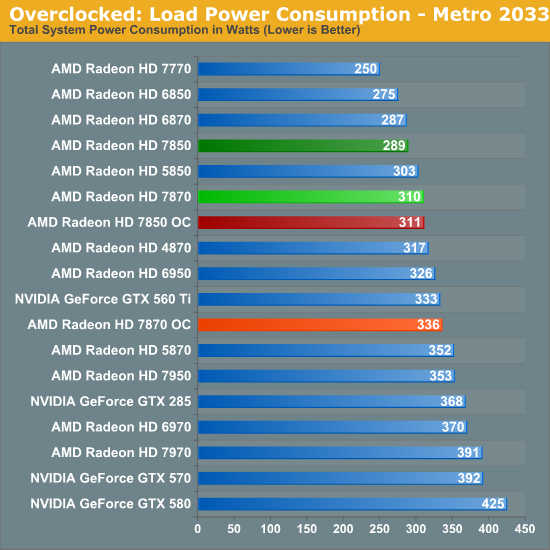
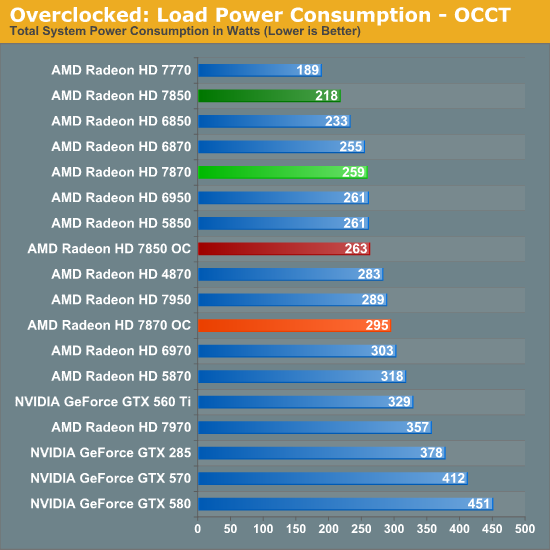
Even without a voltage increase overclocking does cause power consumption to go up, but not by a great deal. Under Metro the total difference is roughly 21W for the 7850 and 25W for the 7870, at least some of which can be traced back to the increased load on the CPU. Whereas on OCCT there’s a difference of nearly 40W on both cards, thanks to the increased PowerTune limits we’re using to avoid any kind of throttling when overclocked. All things considered with our overclocks power consumption for the 7850 approaches that of the 7870 and the 7870 approaches the GTX 560 Ti, which as we’ll see is a fairly small power consumption increase for the performance increase we’re getting.
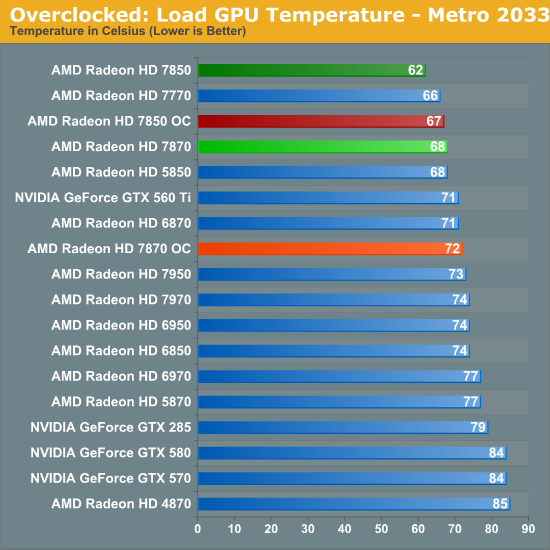
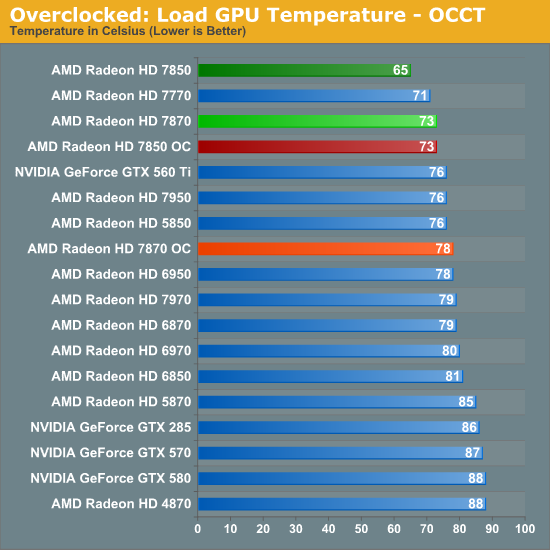
Of course when power consumption goes up so does temperature. For both cards under Metro and for the 7870 under OCCT this amounts to a 5C increase, while the 7850 rises 8C under Metro. However as with our regular temperature readings we would not suggest putting too much consideration into the 7950 numbers since it’s using a non-retail design.
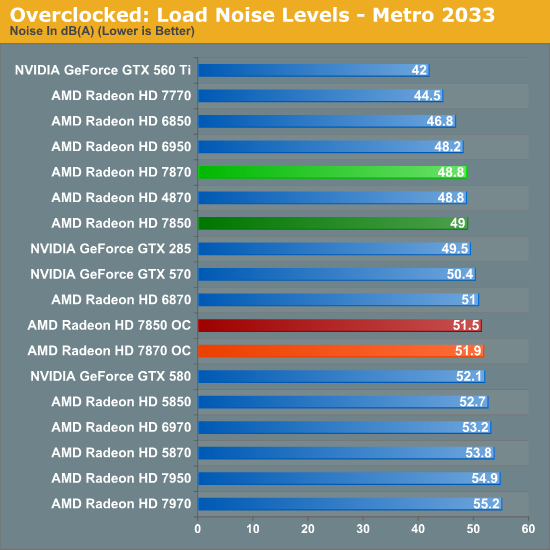
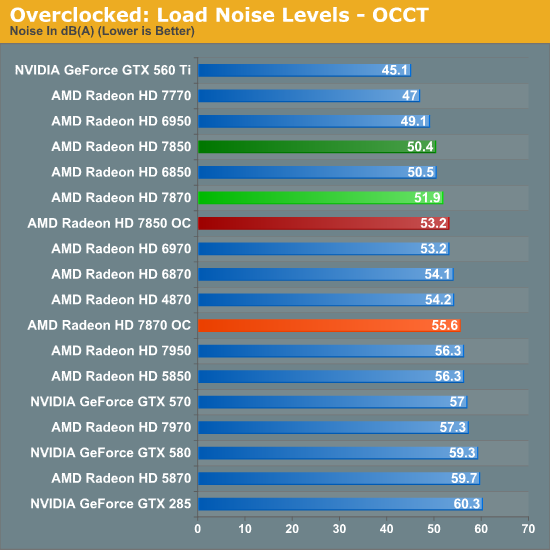
AMD’s conservative fan profiles mean that what are already somewhat loud cards get a bit louder, but in spite of what the earlier power draw differences would imply the increase in noise is rather limited. Paying particular attention to Metro 2033 here, the 7870 is just shy of 3dB louder at 51.9dB, while the 7850 increases by 2.7dB to 51.5dB. OCCT does end up being worse at 2.8dB and 3.7dB louder respectively, but keep in mind this is our pathological case with a much higher PowerTune limit.










173 Comments
View All Comments
ET - Monday, March 5, 2012 - link
I agree it's kind of disappointing. Even a 5750 was a good improvement over a 3870, and here there's nothing approaching this kind of performance benefit over the 5870 from these. Though I think part of it is that the 5870 still holds up well in many games, as these benchmarks show.Kjella - Monday, March 5, 2012 - link
I don't think it's that terrible... the 7870 fits pretty much the exact same power envelope as the 5850 and is starting to be a pretty solid performance upgrade. Yes it's a $350 card but inflation adjusted the $279 (pre-hike) 5850 is nearing $300 in 2012 dollars. A good deal and a good cooler (the reference cooler on the 5850 works, but is hardly quiet) and they may get a sale. Just waiting for Ivy Bridge, if nVidia hasn't shown a stunning Kepler by then I think the 7870 is it.Death666Angel - Tuesday, March 6, 2012 - link
Average increase of 40% in performance and you are comparing a high-end graphics card to a mid-range graphics card.DominionSeraph - Monday, March 5, 2012 - link
So, AMD discontinued the $250 6950 and $350 6970 to give us... a $250 6950 and $350 6970.Not exactly impressed.
Looks like it will be up to Nvidia to save us, just as they saved us from the price-gouged 5000 series with aggressive release price of the GTX 460 with price drops on the GTX 470. (That one action set the pricing scheme throughout the 6000/500 series)
CloudFire - Monday, March 5, 2012 - link
I'm not upgrading this cycle but I do wish to see Kepler out sooner to drive down prices. This is business and AMD has a few months of no competition so they are going to do all they can to reap massive profits.Nvidia isn't going to save you, they would do the same thing if they were in AMD's position. Remember nearly 5 years back with the 8800GTX going for 500+ for over a year? Yea......
DominionSeraph - Tuesday, March 6, 2012 - link
A halo product with no competition is beside the point. We're talking about the 7800 series which sits right in a range where there are competing products, and AMD is pricing it to suck you dry.The fact is that the 7000 series is not undercutting the 500 series the way Nvidia undercut the 5000 series. A $250 7850 vs a $270 + free Batman Arkham City GTX 560 Ti 448 Cores is about equal price/performance (maybe a tad in the favor of Nvidia). Contrast this to the GTX 460 being released at $200 when the 5770 was $180. The GTX 460 blew the doors off the 5770 and instantly said the appropriate price for that card is ~$130. A few months later we were seeing $110 5770's and $150 GTX 460's, and that's where we've been at ever since.
AMD refuses to aggressively compete with Nvidia. They simply slot their products into Nvidia's pricing structure. So prices only change when Nvidia drops theirs and AMD is forced to follow. This means that we, the consumers, are dependent on Nvidia to save us, because AMD sure as hell won't.
Exodite - Tuesday, March 6, 2012 - link
Not really a valid point of comparison though.Looking through several reviews of the 7800-series the 7850 lies closer to a 570 than a 560 Ti most of the time, while offering more and better in every possible category.
Sure, the 7850 isn't on the market yet but assuming the ~250 USD pricing holds true I couldn't possibly recommend a 560 Ti, or even 448 core version, over the 7850 with a straight face.
It could still be cheaper, sure, but it's nowhere near the pricing disaster the 7900 and 7700 series are.
To my mind the 7800 series were the ones to wait for.
Granted, with a 6950 myself I won't be upgrading until the 8k-series at the earliest. Unless Kepler turns out truly amazing, and brings triple display functionality on a single card.
tipoo - Monday, March 5, 2012 - link
If I recall Nvidia hasn't really under-priced AMD in recent memory, they've always tried x more performance sold for >x price.ET - Monday, March 5, 2012 - link
"AMD discontinued the $250 6950 and $350 6970 to give us... a $250 6950 and $350 6970."When you put it this way, it's quite a likeable upgrade actually. Slight boost in performance, lower power and better thermals, upgraded features, all for the same price. What's not to like?
chizow - Monday, March 5, 2012 - link
What's not to like is it took them 16 months to put out a greener refresh sidegrade.